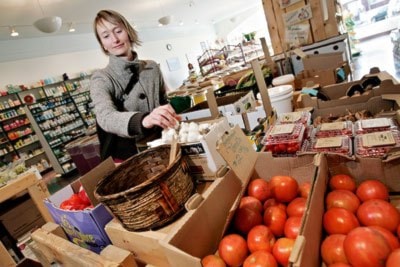When you’re on a tiny social assistance, what can you eat?
Currently, the monthly food allowance under social assistance is $201 per person, equal to $46.90 per week or $6.50 per day.
In one day, someone on a food allowance can buy three items off the McDonalds’ value menu.
Or a six-inch sub at Subway.
Or a box of Cheerios and a personal-sized milk carton.
Or four bags of dry spaghetti.
From October 5th to 11th, nutritionist Jennifer Eskes signed up a team of volunteers for The Food Challenge, an effort to “go social assistance” for an entire week. Steaks, pomegranates and oranges were sworn off, and six family groups, including Whitehorse councillor Dave Stockdale and CYFN vice-Chief Shirley Adamson, dove into the financial rigours of strict food budgetary.
Flavour was the first casualty.
“We ate a lot of oatmeal, rice, pasta, less expensive fruits and vegetables,” said Elizabeth Parker, a Whitehorse chiropractor and Food Challenge participant. Normally, her diet is a steady stream of fish and fresh fruits and vegetables.
Style was still possible — Parker said she whipped up a good chick pea curry.
But fancy spices and sauces were a thing of the past.
“Things were generally pretty plain, just pasta with tomato sauce,” said Parker.
And the spice of life? Variety? Forget about it.
The whole exercise was an effort at empathy generation, as well as a loose examination of nutritional difference between a “rich” and “poor” diet, said Eskes.
“I wanted people to not just think ‘Oh, you only have $6.50 a day to live on, that sucks,’” said Eskes.
“I wanted people to do it themselves, because there’s a real difference between knowing and experiencing,” she said.
Food challenge participants instantly saw their priorities skewed in a way that would have made Maslow proud.
Food suddenly leapt to the top of the worry pile.
“I definitely felt more stressed about food, because I’m used to going to the grocery store and buying what I want, and if you run out of something you can go get more,” said Parker.
“But on a fixed budget you don’t get that luxury,” she said.
Meal planning was essential, with participants treasuring every scrap of leftovers. Supermarket sales skyrocketed in importance, treats were made instead of bought and wild meat became an essential budget-reliever.
“Some participants had noted that they were bored of eating leftovers or eating the same foods each day,” said a report drafted at the end of the challenge.
“There were very few ‘convenience’ foods purchased, most meals were made from scratch,” it said.
The time and ingenuity needed by Canada’s poor gained newfound admiration from Food Challengers.
“You have to source out sales, you need to be thrifty, you need to cook and be creative,” said Eskes.
“It’s hard to be poor and it takes a lot of resources in the sense that you really need to be on it,” she said.
Health-wise, tight budgets are causing the poor to lag behind other Canadians, although not in the oft-conceived Dickensian image of the “skinny poor.” In the modern era, obesity is the greatest concern for those under the poverty line.
“There is a significant link between obesity and poor nutrition and lower income,” said Eskes.
“It’s a lower quality of food that people on a budget can afford to eat — more empty calories, like Kraft Dinner,” she said.
Overall, participants were able to eat at least one serving from each food group every day, but the fruit and vegetable and meat alternatives categories were often lacking, due to their higher cost over grain products, which can be bought in large quantities without spoiling.
Diet is not the only thing affected by a small food budget, said Eskes. With food being a cornerstone to so many leisure activities, a social life can be severely constrained by financial limitations.
“When you’re not on social assistance and you’ve got that $5 in your pocket, you don’t even think twice about going out for coffee,” said Eskes.
“What else are you going to do? That’s like the lowest cost social activity that you can do,” she said.
Eating out was extremely limited, if not impossible, reported the nutrition assessment.
“We just forget that those little things that break up the monotony of your life are important to everybody, whether you’re on social assistance or not,” she said.
Tweny-one per cent of Northerners reported being food insecure compared to 14.7 per cent of the rest of Canada, reported a national health survey in 2000/2001.
In 2007, Yukon, NWT, and Nunavut had a 19 per cent increase in food bank usage since the previous year. Two per cent of the Yukon population used a food bank in 2007
In 2005, Statistics Canada reported that 10.5 per cent of Canadians lived below the poverty line. A Canadian is deemed to be below the poverty line when they spend 20 percentage points more of their gross income on food, shelter and clothing than the average Canadian.
Whitehorse food bank services have themselves been running into budgetary constraints, said an official Food Challenge release.
Mary House, one of two Whitehorse food banks, has decreased food bank services from 3 days per week to 2 days per week due to lack of resources. In April, 2007 Mary House was often closed due to depleted food stores.
